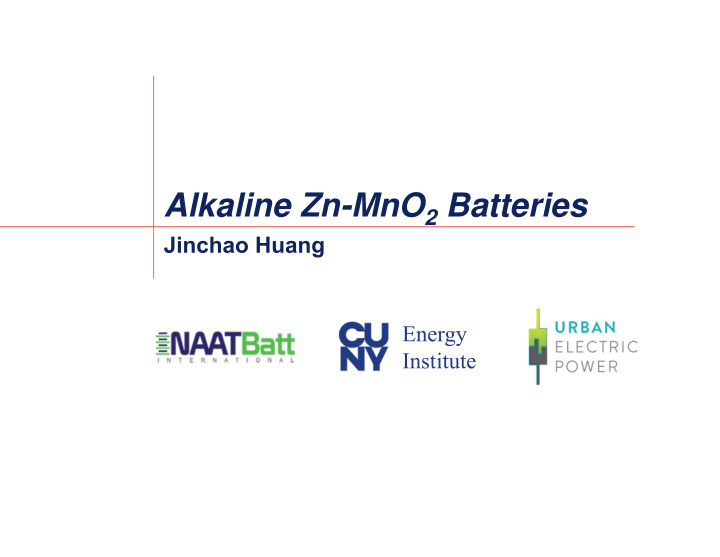



Alkaline Zn-MnO 2 Batteries Jinchao Huang Energy Institute
Zn-MnO 2 Batteries Zn-MnO 2 Batteries Lowest bill of materials cost, low manufacturing capex Established supply chain for high volume manufacturing Readily be produced in larger form factors for grid applications Traditionally primary batteries at $18-25/kWh with long shelf life Do not have the temperature limitations of Li-ion/Pb-acid Inherently safer, e.g. EPA certified for landfill disposal The ultimate challenge in Zn-MnO 2 batteries is reversibility 2
Making Zn-MnO 2 Rechargeable Making Zn-MnO 2 Rechargeable Earlier approaches to make rechargeable Zn-MnO 2 cells not successful – Dendrite formation, passivation and shape change on cycling Zn anode; crystal structure collapse and formation of inactive species on cycling MnO 2 cathode CUNY approach for long cycle life at 10-20% utilization – Innovations for anode: charging protocol, electrode additives, electrolyte composition, and zinc metal anode coating/binding/pore structure to mitigate shape change, passivation and pore plugging – Innovations for cathode: electrode composition, coating procedures, electrolyte composition, controlled porosity and conductivity, and charge/discharge protocol 3
Limiting the Depth of Discharge to Achieve Long Cycle Life Limiting the Depth of Discharge to Achieve Long Cycle Life Electrolytic γ‐ MnO 2 (EMD) 4
Shallow-Cycled 1-e Zn-MnO 2 Success Shallow-Cycled 1-e Zn-MnO 2 Success Coulombic Efficiency Energy Efficiency H 2 O+e - EMD (γ-MnO 2 ) α-MnOOH Charge Capacity (Blue) 1 st electron reaction Discharge Capacity (Purple) The 1-electron-cycling strategy maintains the γ- MnO 2 crystal structure 1-electron Zn-MnO 2 cells with 4000 cycles led to first products by Urban Electric Power 5
UEP Product Evolution: 100Ah Prismatic to 200Ah UEP Product Evolution: 100Ah Prismatic to 200Ah Cylindrical Cylindrical Semi-log fit 1000 100 Cycle Life 10 • Two prismatic cells are equivalent to one cylindrical cell in capacity 1 • Electrodes and separators have identical thicknesses and compositions 0 20 40 60 80 100 • Performance characteristics of both types are very similar MnO 2 Utilization (% of one electron) 6
Utilization of 2e - Challenges Utilization of 2e - Challenges On the MnO 2 Cathode • Crystal structure breakdown Zn-MnO 2 • Formation of Inactive phases • Reducing susceptibility to Zinc poisoning 616 mAh/g Separator: 820 mAh/g Zn MnO 2 • Reduce Zincate crossover On the Zn Anode: • Control shape change • Passivation • Reduce dendrite formation Need improvements in materials utilization, process optimization and engineering larger format cells. 7
Potential for Zn-MnO 2 Cells: $50/kWh Potential for Zn-MnO 2 Cells: $50/kWh • Recent breakthroughs in making MnO 2 fully rechargeable. Based on the formation of a layered birnessite MnO 2 structure and stabilizing this structure for thousands of cycles. • Improvement in energy density and cost by improvement in zinc utilization • Cathode degradation mitigation by improvements controlling Zn migration across separator • Potential for $50/Wh cells with high cycle-rechargeability of Zn-MnO 2 Source: CUNY Energy Institute 8
Thank you! 9
Low DOD discharge makes for a viable Low DOD discharge makes for a viable technology technology 5% DOD 10% DOD 20% DOD RAPID CELL DEATH >30% DOD Single-use Alkaline Battery Gen 1 Alkaline Battery http://www.urbanelectricpower.com 10
Recommend
More recommend